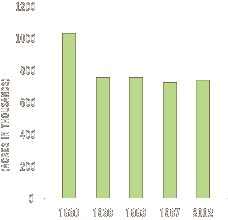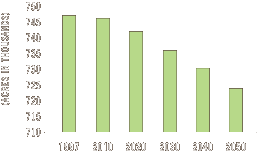Forest Facts
WATERSHEDS ARE DISAPPEARING UNDER CONCRETE
A recent U.S. Forest Service study found that the number of watersheds subject to growing housing density in the next 25 years is huge. If current trends continue, we will have lost about 23 million acres between 1997 and 2050, an area the size of Maine – not to logging, but to parking lots and highways. From 1982 to 2003 we lost about 4,000 acres per day to development. There’s no watershed benefit from a subdivision. And when woodlands are divided into smaller parcels, it becomes more and more difficult to manage them for wildlife, water quality or pest and fire prevention.
Almost one-third of drinking water in the U.S. comes from forested land.

AMERICA'S FOREST ESTATE (HISTORICAL)
Today about one-third of the U.S. is forested. While total forest area has been relatively stable for the last 100 years (currently about 747 million acres), there have been significant regional shifts in the area and composition of the nation's forests as land has been rapidly changing ownership.

AMERICA'S FOREST ESTATE (PROJECTED)
Urbanization, conversion to agriculture and natural disasters have been major factors contributing to loss of U.S. forests. A prime example is the state of Maine, where it is estimated that more than 60,000 acres of forest have been cleared in recent years to make way for development.
ARE WE MAKING TREES WORTH MORE DEAD THAN ALIVE?
Are we, as consumers with the best intentions actually helping to make trees worth more dead than alive? “Think before you print” takes on a new meaning when you consider that instead of keeping trees from being cut down, using less paper may actually keep trees from being planted.
Forests are renewable. When managed sustainably, they are harvested and replanted responsibly with due consideration for wildlife, biodiversity and their ability to create watersheds and sequester carbon. In short, they are providing benefits for millions of people, not only as scenic beauty, but more importantly as a source of clean air and clean water.
Help private landowners protect our precious ecosystem. Support the responsible use of print, paper and other wood products.
Sources: Forest Resources of the United States, 2007, U.S. Forest Service and Family Forest Owners of the United States, 2006, U.S. Forest Service
NEXT: Meet a tree farmer.